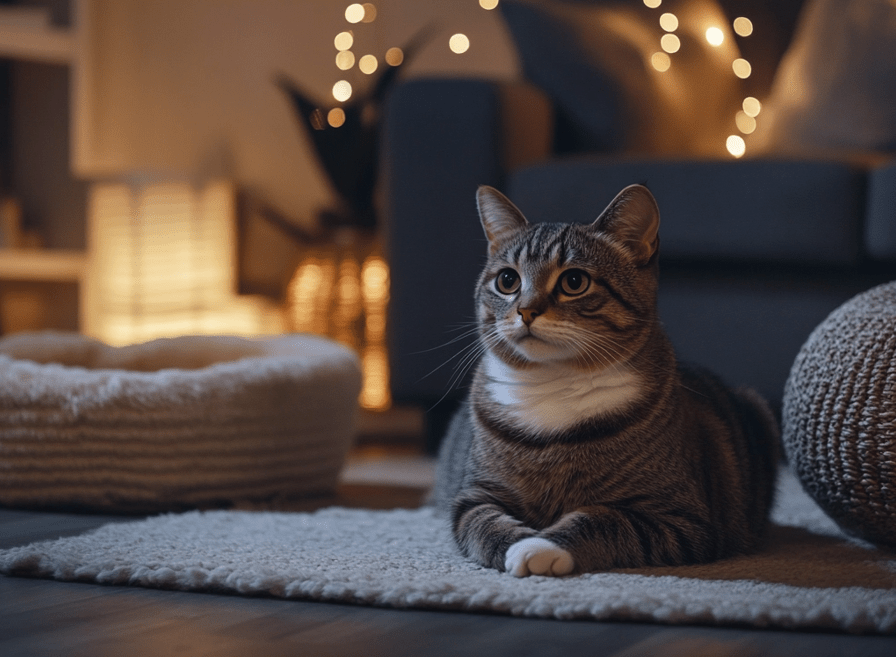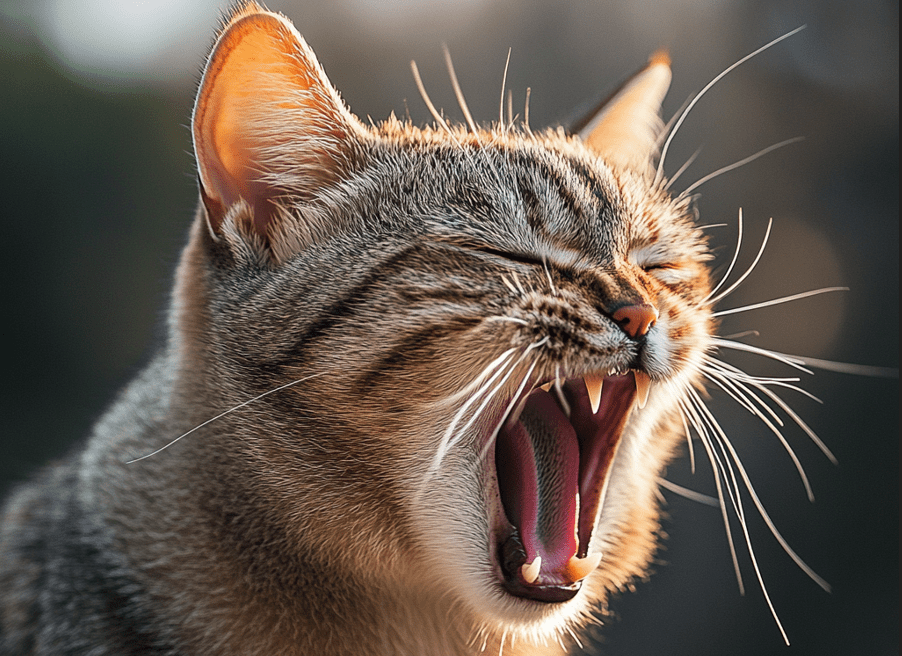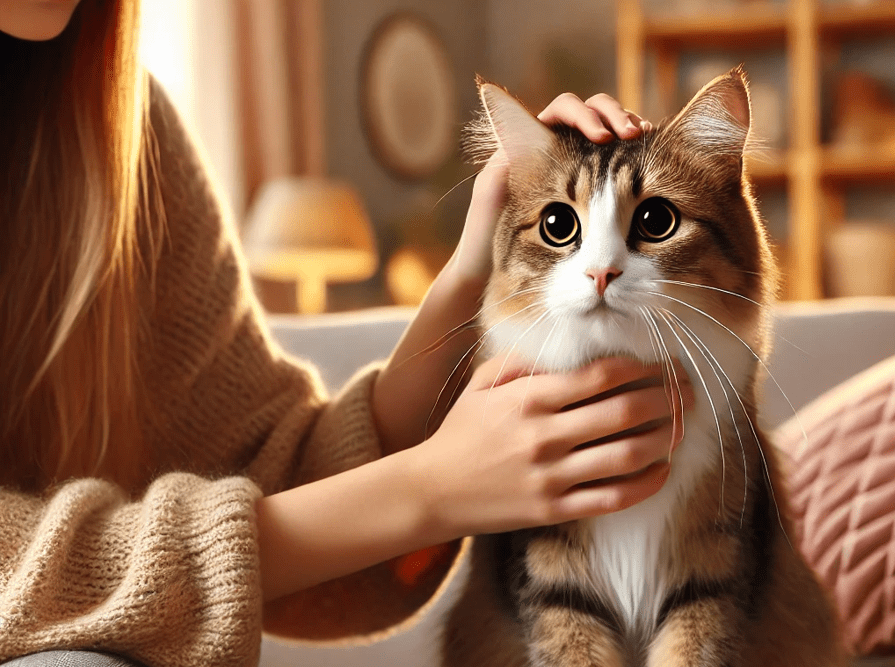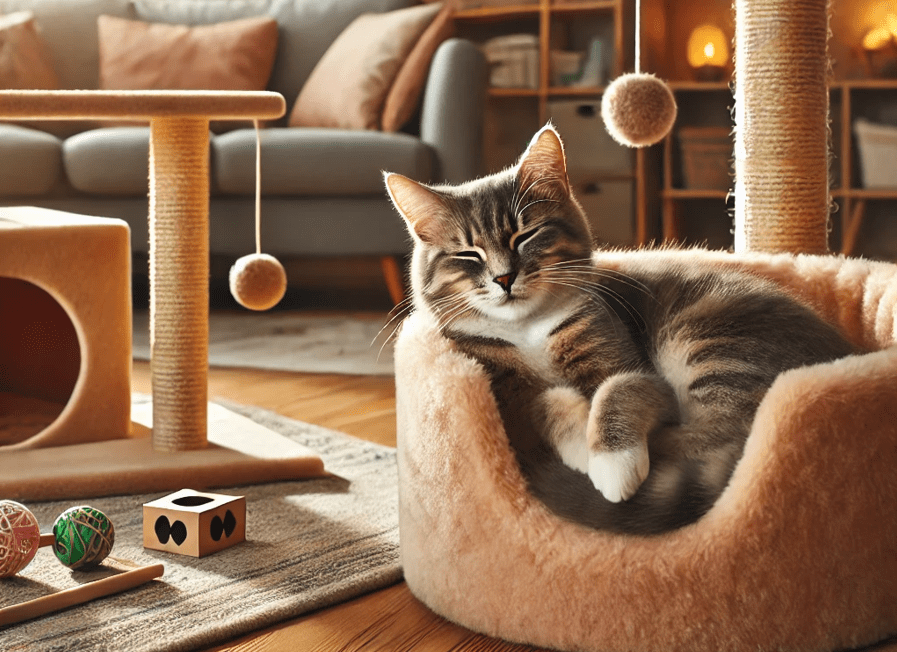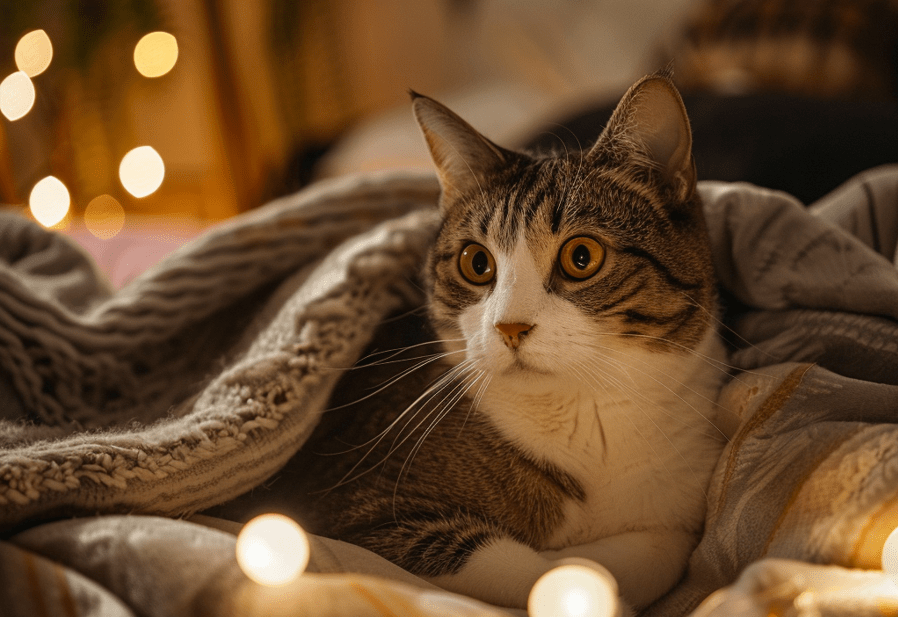
Managing anxiety in cats is crucial for maintaining your feline friend’s well-being at home and ensuring a peaceful coexistence between you and your cat. Cat anxiety is serious and can cause emotional and even physical health issues (like urinary tract problems) in cats. An anxious cat can also display less than desirable behaviors, like peeing outside the litter box or vomiting. We discuss some of the reasons why a cat may be anxious, the signs to look out for, and how best to treat and manage the condition below.
Understanding Anxiety in Cats
Many cat behaviors may seem random and unpredictable. For example, storming out of a room and immediately coming back a few seconds later could be perfectly normal behavior for a cat. But if your cat is acting overly distressed for no apparent reason, it may be due to anxiety. Elevation in Cat Anxiety occurs prior to a threat, a perceived threat, or when there is a possibility of losing or removing a particular source in life. This perceived threat produces a physical response, resulting in external signs of stress.
Feline anxiety can be triggered by specific events or due to a traumatic experience. It is commonly associated with changes in the environment, such as relocation to another house, home renovations, a new family member or pet or loud sounds of nearby construction, among other reasons.
Although most cat owners notice signs of anxiety for the first time between 5 months and 1 year of age, this behavior can develop at any point in a cat’s life. Since anxiety gets worse over time, it is important to address stressors and seek treatment as early as possible.
Symptoms of Anxiety in Cats

Anxiety can take many forms, and its symptoms are not always evident. In short, any notable behavior changes, particularly after an environmental shift should be monitored closely.
Common Symptoms of Cat Anxiety:
1.Over grooming, which may lead to hair loss or bald patches
2.Not using the litter box (urinating outside the box)
3.Aggressive or possessive behavior
Other Symptoms of Cat Anxiety:
1.Seeking cover, going to escape, or too much movement
2.Trembling or shaking
3.Pacing or restlessness
4.Reduced appetite
5.Increased vocalization (such as meowing or yowling)
6.Signs like a tightly tucked tail, flattened ears, or raised fur
Anxiety may also lead to health problems such as Feline Lower Urinary Tract Disease (FLUTD) and Upper Respiratory Infections (URIs). Signs of these diseases include increased urination difficulty (FLUTD), as well as increased frequency of urination (FLUTD) and sneezing, congestion, or nasal discharge (URIs). So if your cat gets sick over and over again, consider the possibility that she suffers from anxiety.
What may make your cat anxious?
Different factors may lead to anxiety in cats such as:
1.Environmental changes (e.g., moving into a new house, changing the structure of your home, changing litter types, or adding a new family member or pet)
2.Traumatic experiences
3.Illness or physical pain
4.Not enough socialization when they were a kitten
It is important to identify the exact cause of your cat anxiety in order to deal with the problem successfully. Think about changes at home that may be stressing them out. And in addition, watch your cat throughout the day to see when and where their anxiety symptoms are the most obvious. A log of their activities or videos to send to your veterinarian can help you and your vet pinpoint the cause.
Learning how to identify and respond to anxiety in your feline friend will help you facilitate for a relaxing and supportive home for your furry family member.
Diagnosing Anxiety in Cats
Diagnosing anxiety in cats will be largely dependent on a thorough description of your cat’s behavior, and your veterinarian may perform diagnostic tests, like bloodwork or urine analysis, to rule out any medical problems that could be responsible for the behavioral changes.
It’s vital to give your vet as much information as possible regarding your cat’s symptoms and any recent changes in behavior. This will assist your vet in determining the exact triggers for your cat’s anxiety and aide in forming an effective treatment strategy specific to your cat’s needs.
How to Treat and Manage Your Cat’s Anxiety
The best way to combat anxiety in cats is usually a multi-faceted approach. These can include behavioral modification techniques, changes to your cat’s environment, use of natural calming remedies, and, in more serious cases, anti-anxiety medication. Finally, if a medical condition is contributing, the condition must be treated as part of the treatment plan.
Any treatment plan needs to be consistent and you need to also be committed. It could take your cat months to overcome their anxiety or the symptoms to become manageable. Be patient, as just minor changes in behavior, and/or symptoms can greatly affect and improve your cat’s wellbeing and quality of life in the long term.
Environmental Anxiety in Cats
The first step in managing anxious behavior in a cat is identifying the cause of the stress and mitigating it if possible.
Cats are territorial by nature, and when an intruder (such as a new family member or pet) is invading their space or resources, it can create anxiety. In such a situation, make sure that your cat has its own space where it can feel safe and alone.
How to Create a Safe Space for Cats
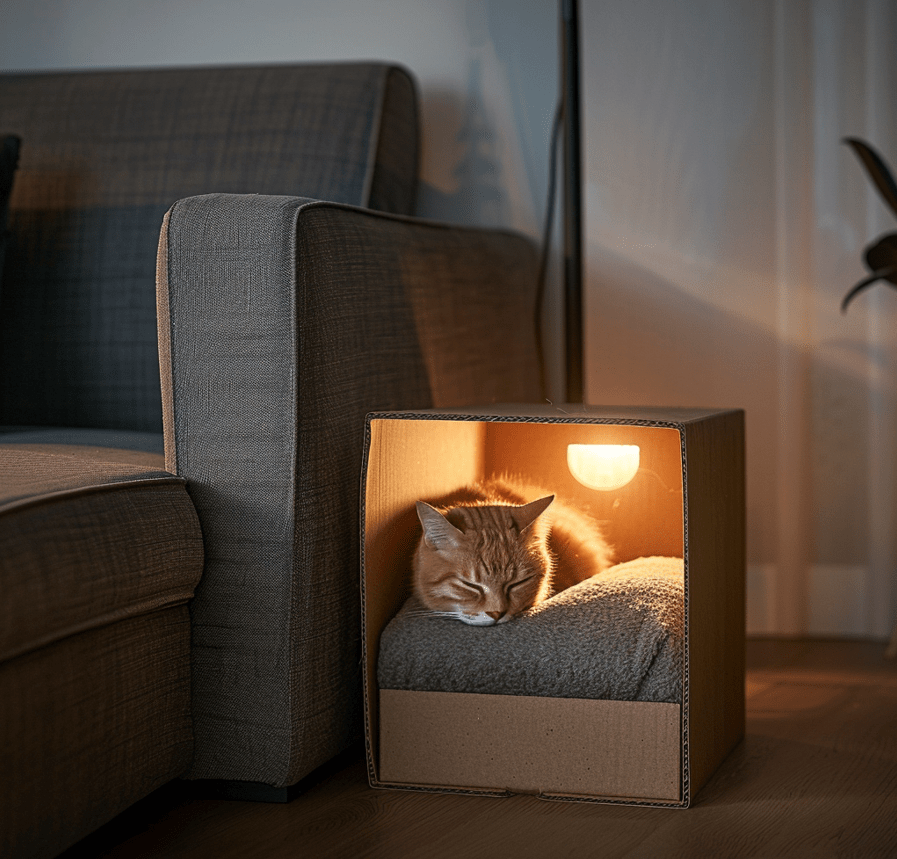
If your cat gets stressed around other animals, noise or anything outdoors, create a quiet area it can retreat to that is dark. Using simple items like cardboard boxes or draped sheets, you can build a cozy, secure environment. Be sure it includes all the necessities: food, water, bedding, a litter box and toys. In smaller homes, give your cat more vertical space by erecting cat trees or shelves. Also, spend some quality time with your cat to avoid jealousy and make it feels secure.
Where to Place Litter Boxes
Litter boxes should be placed strategically. Don’t put them in tight corners or dead ends where your cat might feel cornered. Instead, use locations that have multiple entry and exit points to instill a sense of safety. In homes with several cats, allow one more litter box than there are cats, and make sure that each level of your home has at least one litter box.
Separate Feeding Areas
When your cat eats in front of other pets, cats can feel threatened. To prevent it, distract each cat separately — they should not see other animals when they eat.
Physical & Mental Activity
Exercise and enrichment are another important part of minimizing anxiety in cats. Depending on the cat, it can be easy to become restless or nervous if it has pent-up energy so be sure to offer plenty of toys and enrichment activities and engage in daily playtime to help your kitty remain calm and happy.
With some targeted efforts to reduce exterior pressures and make your kitty feel more at home in your environment, it can make all the difference in your indoor feline’s level of chaos.
How to Use Natural Pheromone Sprays for Cat Anxiety Management
Cat pheromones are a natural, effective and easy way to reduce anxiety in cats. These pheromones are hormones that cats (and other species, including humans) secrete in particular situations or emotional states. Other cats are able to sense these pheromones and read them as directed messages. For example, a relaxed or happy cat will produce milli-gallons of good pheromones, and an anxious or possessive cat will produce pheromones that signal fear and/or alert other cats.
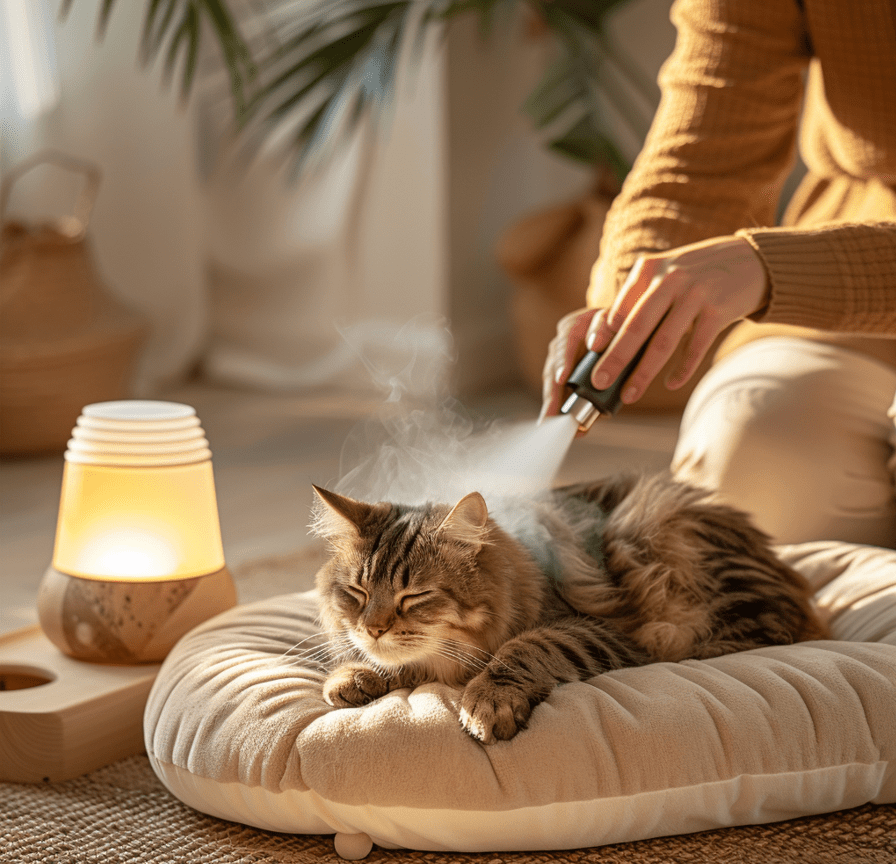
Pheromone sprays and diffusers replicate the happy, soothing pheromones cats associate with safe, relaxed spaces. They can help calm stressed or anxious cats by creating a comforting space. Sprays could be applied to bedding, scratching posts and other places where cats spend a lot of time, while diffusers can be plugged into wall outlets by common areas or the litter box.
Feliway is another brand that is frequently recommended; they provide a variety of pheromone products. For example, Feliway Original works to alleviate stressors like moving to a new home, and Feliway Multicat helps to alleviate tension in homes with more than one cat. Another option with a continuous calming effect is pheromone-diffusing collars.
Behavioral Training Techniques for Cats
Two very effective techniques commonly used to manage feline anxiety are desensitization and counterconditioning
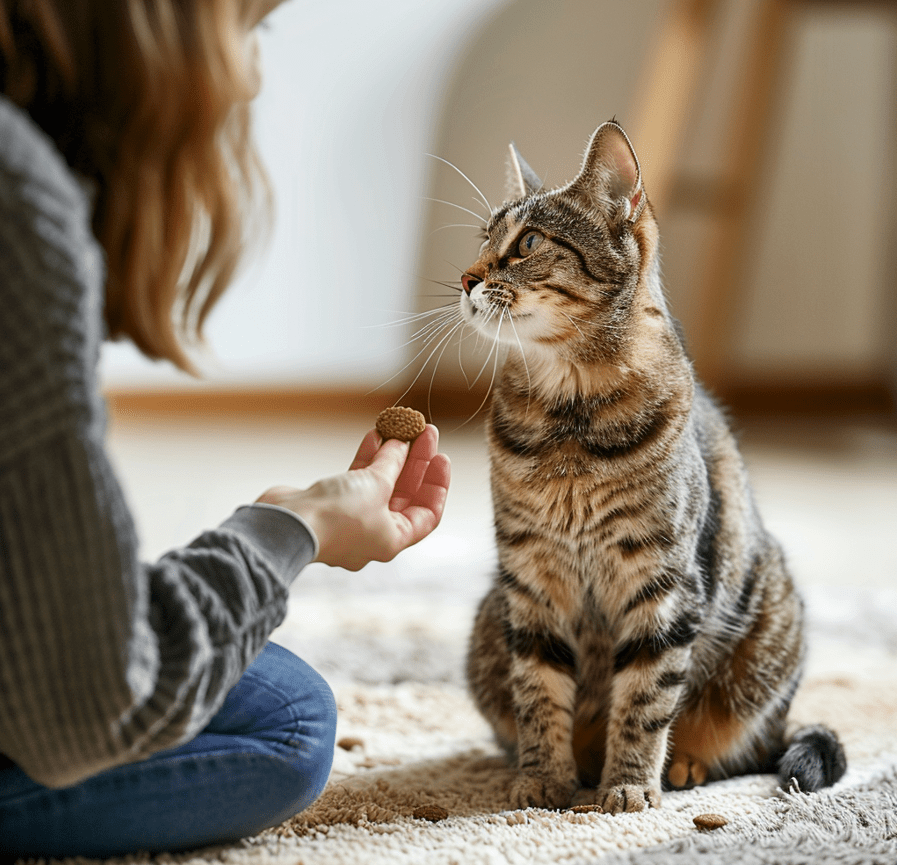
Desensitization: Desensitization means exposing your cat step by step to the thing that scares them or causes anxiety, in a way that’s controlled and in low intensity. The target is to get them used to the stimulus without arousing a fear response. Eventually, after several more exposures and plenty of positive reinforcement you can lessen their anxiety.
If your cat is scared by a specific sound (for example, a dog barking), play the sound at a low volume while your cat is relaxed. Play the recordings progressively louder throughout many sessions, always making sure your cat stays relaxed. It’s important to work under their fear threshold — that is, the stimulus should never be upsetting. Watch their body language, including ear and tail position, and end the session if you notice any signs of discomfort.
Counterconditioning: Counterconditioning is used to change your cat’s emotional response to the cause of their anxiety. This will offset their anxiety with something positive, like treats or playtime, and teach them to react to that stimulus with a calmer or happier response.
For example, if your cat is scared of a fellow pet, give them a delicious treat every time they see the other animal. Gradually, they can learn to connect the other pet with positive experiences, and this can help to decrease their fear.
Anti-Anxiety Medications for Cats
If you are in extreme anxiety, your veterinarian will prescribe anti-anxiety medicines. These may include fast-acting options for short-term use, such as before a stressful event like a vet visit, or long-term medications, such as antidepressants, that aid in managing chronic anxiety over the course of months or years.
But medications work better when combined with behavioral training and environmental adjustments than as a solo approach.
Cost for Treating Feline Anxiety
The price for anxiety in cat’s treatment depends on the degree of the condition and the needed therapies. These can include vet visits, medications, diagnostic tests, and training sessions to address behavioral issues. Visits can cost anywhere from a few hundred dollars to thousands, depending on how long and holistic the care is.
Summary of Feline Anxiety
Anxiety is a normal reaction but, if it remains unaddressed, it can affect your cat’s quality of life and even his or her health. With a combination of behavioral training, environmental changes, calming pheromones and medication if necessary, most cats can have their anxiety lessons, and go on to lead happier, less stressful lives. To deal with this condition properly, you will need to take early intervention and get professional advice.

